Seriation
Seriation: a method of relative dating, in which artifacts are chronologically arranged.

In archaeological excavations, the older objects are usually found under the younger ones. This allows archaeologists, if they have access to finds from several sites, to identify the development of certain objects. For example, on the photo to the right, we can see several axes from the Bronze Age, arranged from left to right, from old to young.
A Seriation of Axes
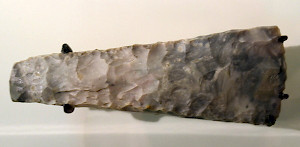
Our second photo shows a flint axe from the final phase of the Neolithic age, which is, in Northwestern Europe, about 3000 BCE. Made of flint stone, it was found in Denmark. Prehistorical archaeologists use a German name for this type of axe and call it a Rechteckbeil, which means that it has a quadrangular shape. The shape of the Neolithic axes was copied when the first axes were made of bronze.
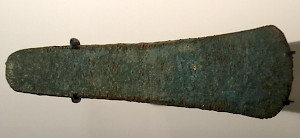
The third picture shows a very old bronze axe from the Early Bronze Age, found on an unknown place in Northwestern Europe. In this region, the Early Bronze Age begins several centuries later than in the Near East; we cannot be too far from the correct date if we place this object somewhere between 2200 and 1700 (which is more or less contemporary to the Near Eastern Middle Bronze Age). This type of axe is called a Flachbeil, a flat axe.
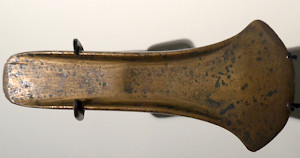
In the Middle Bronze Age, which we can date to 1700-1400 BCE in Northwest Europe, the metal workers began to better understand the qualities and possibilities of bronze. This alloy offered all kinds of opportunities for technological and therefore economic innovation. By adding an edge to an axe, it could be better attached to the shaft. Besides, less metal was needed, making axes cheaper and therefore more accessible. This type is called a Randleistenbeil and the photo to the right shows an example from Elen in Belgium.
By now, metal workers had started to add decorations to the axes. This proves that these objects had functions other than practical ones, for example as status symbols.
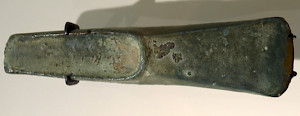
The next axe is a palstave (German: Absatzbeil) excavated in Kinkempois, a village that is now part of the Belgian city of Liège. It is a little younger than the Randleistenbeil above, but can still be dated to the Northwest European Middle Bronze Age. We can clearly distinguish how this metal object might be placed on a piece of wood. Undoubtedly, the wooden shaft would have been cut with axes like this, proving that woodworking techniques benefited from improved metalworking technology and vice versa.
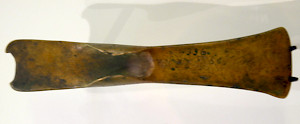
In the intiatl phase of the Late Bronze Age, which can in Europe be dated between 1300 and 1100 BCE, another method of attaching a bronze axe to a wooden shaft came into fashion, as can be seen on the next photo: a winged axe from Rheineck, a village on on Lake Constance in Switzerland. This type of axe belongs to what is often called the Urnfield culture, a culture in Central Europe that is the direct ancestor of theCeltic civilization.
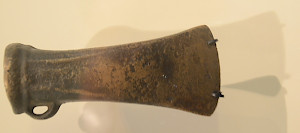
At the very end of the Late Bronze Age (1300-800 BCE in Europe), the bronze axes were even better attached to the shafts, namely by making the metal object completely hollow, as if it were a tube. In German, it is called a Tüllenbeil, i.e., an axe in the shape of a spout. Less bronze was needed to make these axes. Often, the axes had a ring, which made it possible to create an extra connection between the shaft and the axe. The metal utensils also became shorter, again saving materials and making axes more accessible. This example is from Beringen in Belgium.
From Relative to Absolute Chronology
Rechteckbeil, Flachbeil, Randleistenbeil, palstave, winged axe, Tüllenbeil: it is possible to describe a development. The first to draft such a series was the Danish archaeologist Oscar Montelius (1843-1921). Of course archaeologists make similar seriations for daggers, swords, buckets, coat pins, pottery and everything else. Creating those seriations was no easy task, because Montelius, who was especially interested in Europe, had to travel all over the continent. However, the result was impressive: for the first time there was an overview of the development of certain objects. Archaeologists were able to determine what was older and what was younger.
Of course, archaeologists want to improve their understanding of the past, trying to move from relative chronology (the development of a category of objects) to absolute chronology (adding dates to the development). Montelius’ trick was to make comparisons. Imagine an axe like the one from Elen, found somewhere in the Balkans, together with some Mycenaean pottery. That meant that they had to be of about the same age. Now this pottery had also been found in Egypt, where this pottery might be found together with a scarab with the name of a king from, say, the early Eighteenth Dynasty. Since we can date the Egyptian rulers, using texts like Manetho’s king list, we can also offer a tentative date to Mycenaean pottery and a very tentative date to our axe. In the third quarter of the twentieth century, radiocarbon dating and dendrochronology offered more precise dates.